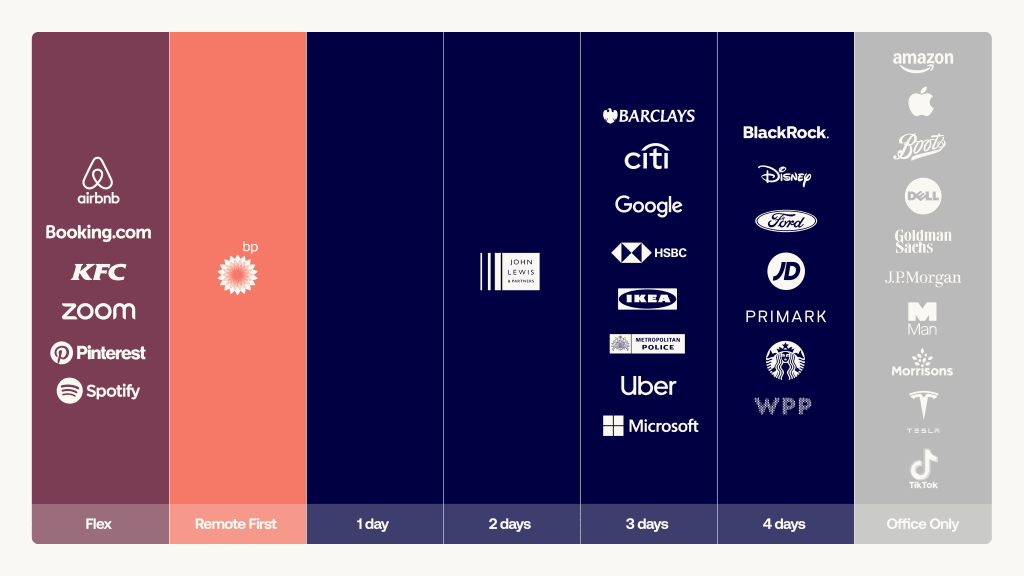33 Leading Companies Return to Office Strategies in 2025
For an increasing number of employees, the era of remote working is coming to an end. As companies begin to reverse their pandemic work policies and implement return-to-office (RTO) mandates, staff are being ordered back to the workplace.
Some companies are now rigorously enforcing onsite working, to the extent that in-office attendance is being linked to employee evaluation and remuneration. Those pushing for RTO compliance believe that creativity, productivity, and performance are enhanced through in-person working. In a 2024 KPMG survey, 83% of CEOs say they expect everyone will be back in the office full-time by 2027.
Meanwhile, other companies remain content with more flexible hybrid arrangements. Advocates of remote working claim that RTO strictures alienate employees and deter future talent. Hybrid models, they say, promote freedom of choice and trust, which reinforces company culture.
RTO policies are currently being met with varying responses, from acceptance to pushback to outright defiance. According to a 2025 report commissioned by London black taxi app Gett, more than half (55%) of the UK’s workers would happily return to the office five days a week. Elsewhere, researchers from King’s College London found “growing worker resistance to rigid office mandates” between 2022 and 2024, with only 42% of employees saying they would comply with RTO demands. And data from Owl Labs and The Conference Board reveals that 66% of employees are actively looking for new roles due to expanded RTO requirements at their current place of work – a figure which increases to 79% for Millennials and 84% for Gen Zs.
Companies (RTO) returning to office matrix

The importance of strategic planning
As the RTO debate continues to swirl, companies need to ensure their physical workspace can accommodate and support their proposed working arrangements. Some firms that have issued in-office mandates, for example, have found themselves struggling with insufficient desk space and inadequate facilities. Similarly, without careful scheduling, onsite occupancy levels can become unmanageable within hybrid schemes.
In short, preparing for RTO implementation requires a great deal of workplace strategy planning.
If you’re currently assessing your options, it’s worth considering how other companies are managing their in-office policies. Who’s doing what and when? What’s the rationale? To help you gain a clear picture, this article provides a snapshot of leading companies and their current workplace policies.
Post-pandemic RTO strategies: which companies are returning to the office?
The following companies have deployed a range of RTO strategies, from full-time five-day-a-week mandates to more flexible hybrid arrangements. Some are company-wide, while others target specific employee cohorts. In each case, we’ve tried to highlight the motivating factors behind the decisions made.
Airbnb

Industry: Hospitality
Number of employees: 7,300
HQ: 888 Brannan Street, San Francisco, US
RTO policy/strategy: Work-from-anywhere
As an accommodation booking platform, during and after the pandemic Airbnb noticed an increase in people around the world travelling while working remotely. Believing that ‘digital nomad’ culture “will be the predominant way that we all work ten years from now”, CEO Brian Chesky endorsed a Live and Work from Anywhere policy for Airbnb employees. This policy states that staff can:
“Work from home or an office / Live anywhere in the country you’re employed and compensation won’t change / Have the flexibility to work temporarily from anywhere in the world, with company approval and where regulations allow / Meet up regularly for team gatherings to connect with one another / Work in a highly coordinated way.”
Amazon

Industry: Retail/Tech/E-Commerce
Number of employees: Approx. 1,556,000 (full- and part-time)
HQ: 410 Terry Ave N, Seattle, US
RTO policy/strategy: Five-days-a-week
In January 2025, Amazon’s five-day-a-week RTO mandate came into force, bringing to an end remote working policies introduced during the Covid-19 pandemic. With minimal exceptions, all employees are now expected in-office and on-site fulltime. Explaining the move, Amazon CEO Andy Jassy said:
“We continue to believe that the advantages of being together in the office are significant… it’s easier for our teammates to learn, model, practice and strengthen our culture; collaborating, brainstorming and inventing are simpler and more effective; teaching and learning from one another are more seamless; and teams tend to be better connected to one another.”
Apple

Industry: Tech / consumer electronics
Number of employees: 164,000
HQ: Apple Park, Cupertino, California, US
RTO policy/strategy: Five-days-a-week
In September 2022, Apple launched its hybrid work scheme, requesting employees to come into the office for three days a week, a day more than previously. Speaking at the time, Apple’s CEO Tim Cook explained that the move was designed to enhance “in-person collaboration”.
Since then, Apple’s RTO policy has shifted. Having opted to leave decisions on in-office attendance to team leaders, in January 2025 the company demanded that all staff return to the office five days a week.
Barclays

Industry: Financial services / banking
Number of employees: 850,000
HQ: One Churchill Place, London, UK
RTO policy/strategy: three-days-a-week back-office
In June 2024, thousands of Barclays’ investment banking staff were instructed to return to fulltime in-office work, with external meetings or client visits the only exception to this rule. This mandate was followed in January 2025 with a tightening of hybrid working arrangements for back-office staff, who are now required to work three days a week in-person, instead of two. As a spokesperson for the bank explained:
“At Barclays, we recognise the benefits of balancing flexibility for colleagues with the importance of working together to collaborate in our physical locations. Our minimum time in-office requirements vary between business areas, depending on the nature of work and needs of the business.”
BlackRock

Industry: Investment management
Number of employees: 21,000
HQ: 50 Hudson Yards, New York, US
RTO policy/strategy: Four-days-a-week
Since 2023, employees at BlackRock have been required to work in-office four days a week. In the US, this move was partly driven by BlackRock’s HQ relocation to Hudson Yards, New York, where the company is leasing 1 million square feet of office space over 15 floors. Globally, meanwhile, employees were offered the chance to work remotely for a two-week period, in line with local context and need.
A company memo set out the rationale for the new mandate:
“Career development happens in teaching moments between team members, and it is accelerated during market-moving moments, when we step up and get into the mix. All of this requires us to be together in the office.”
Booking.com

Industry: Travel
Number of employees: 17,500
HQ: Oosterdokseiland, Amsterdam, Netherlands
RTO policy/strategy: Hybrid / flexible
Booking.com continues to believe in the freedom of employees to choose where and when they work. “We are not a remote working company, we are flexible”, says Booking.com’s careers website, which outlines a range of homeworking perks and services for employees, including support with ergonomics and IT. Empowering employees to decide how many days they spend in-office, the company nevertheless stresses the importance of in-person connectivity. Its online workplace pages state:
“We believe in the power of connecting with each other in person as well as being able to plan focus time working at home. Whether in the office or at home, we aim to empower you to do your best work… Our hybrid way of working policy is designed for both the individual need for flexibility and the collective need for a strong community and culture.”
Boots

Industry: Health and beauty retail
Number of employees: 56,000
HQ: Thane Road, Nottingham, UK
RTO policy/strategy: Five-days-a-week
In March 2024, Boots ordered all administrative staff back to the office, five days a week, effective from September of that year. Prompting a massive social media backlash, the retailer was one of the first UK companies seen to be taking a hardline line on flexible working.
As reported in the Guardian, Boots’ fulltime in-office mandate is part of the company’s preparation for a possible sale or flotation. Speaking at the time, former CEO Seb James said:
“There is no doubt in my mind that the informal conversations, brief catchups and ability to meet in groups in person has been far more effective – and better for our unique Boots culture – than the enforced formality of remote meetings.”
Ahead of RTO implementation, Boots made improvements to its head office facilities, including car parking, IT systems, catering and workspaces.
bp

Industry: Oil & Gas
Number of employees: 100,500
HQ: St James Square, London, UK
RTO policy/strategy: Flexible working / role dependent
As the world emerged from the pandemic, in 2021 bp announced that its office-based staff would be requested to work from home 40% of the time. This hybrid model applied to 25,000 staff globally. Since then, flexible working has remained at the heart of bp’s workplace strategy, with no RTO mandates issued by the company. In a message to current and prospective employees, bp’s website sets out its flexible work philosophy:
“We want…you to accomplish your work in a way that works for you. We recognise that your ability to work at a place or time that better suits your needs is both more productive for you and drives our business performance culture.
We believe that flexible working is a key enabler to attracting and retaining a diverse workforce. At bp, you can make informal arrangements to decide how, where and when you work. The ability to work from a different location, or to work outside of set working hours, or to adjust working schedules to accommodate other commitments, are open to as many of our employees as possible, outside of certain restrictions, such as operational needs.”
Citigroup

Industry: Banking
Number of employees: 240,000
HQ: 388 Greenwich Street, Manhattan, New York, US
RTO policy/strategy: Five-days-a-week / hybrid
Currently, 600 of Citigroup’s US-based employees are required to work in-office five days a week – a result of the reintroduction of pre-pandemic workplace monitoring rules by the Financial Industry Regulatory Authority (FINRA). For the majority of Citigroup’s global workforce, hybrid working continues to be the norm, with three days a week in-office and two days remote.
Dell

Industry: Information Technology
Number of employees: 108,000
HQ: Round Rock, Texas, US
RTO policy/strategy: Five-days-a-week
For Dell’s sales employees, a five-day-a-week RTO mandate has been in force since late 2023. This initial requirement was said to reflect the “unique” and “high-energy” environment of the sales floor, with staff performance and productivity thought to be enhanced through in-person working. In March 2025, this mandate was extended to all employees living within an hour of a Dell office or facility. CEO Michael Dell explained the thinking behind this move:
“What we’re finding is that for all the technology in the world, nothing is faster than the speed of human interaction. A 30-second conversation can replace an email back-and-forth that goes on for hours or even days.”
Disney

Industry: Entertainment / video streaming
Number of employees: 233,000
HQ: Burbank, California, US
RTO policy/strategy: Four-days-a-week
In March 2023, homeworking Disney employees were told to return to the office four days a week. In a gesture of mass disaffection, 2,300 staff signed a petition in protest at this change in policy. But CEO Mark Iger pushed ahead with the scheme, insisting that Monday to Thursday were to be “in-person workdays”. Justifying the decision, he said:
“Nothing can replace the ability to connect, observe and create with peers that comes from being physically together, nor the opportunity to grow professionally by learning from leaders and mentors… It is my belief that working together more in-person will benefit the company’s creativity, culture and our employees’ careers.”
Ford

Industry: Automotive
Number of employees: 171,000
HQ: Glass House, Dearborn, Michigan, US
RTO policy/strategy: Four-days-a-week
Ford’s corporate staff have been requested back onsite four days a week, effective from
1 September 2025. With many employees already working in-office three days a week or more, this latest RTO mandate is thought to impact the majority of Ford’s global salaried workforce.
A spokesperson for the car manufacturer said:
“We believe working together in person on a day-to-day basis will help accelerate Ford’s transformation into a higher-growth, higher-margin, less cyclical and more dynamic company.”
Goldman Sachs

Industry: Financial services / banking
Number of employees: 46,500
HQ: 200 West Street, New York, US
RTO policy/strategy: Five-days-a-week
In 2022, Goldman Sachs became one of the first companies to issue a full five-day-a-week RTO mandate. A year later, only key revenue-generating employees (investment bankers, asset managers) had returned as requested, prompting CEO David Solomon to reissue the RTO summons, with other fulltime staff coming under increased pressure and scrutiny. Solomon outlined his office-first philosophy back in 2021, when he suggested that remote working went against the very essence of Golman culture:
“I do think for a business like ours, which is an innovative, collaborative apprenticeship culture, [remote working] is not ideal for us. And it’s not a new normal. It’s an aberration that we’re going to correct as soon as possible.”

Industry: Technology
Number of employees: 183,323
HQ: 1600 Amphitheatre Parkway, Mountview, California, US
RTO policy/strategy: Three-days-a-week
For Google staff in the San Francisco Bay Area and several other US cities, remote working came to an end in March 2022. Told to return to the office for three days a week or more, employees were then informed, in 2023, that in-office attendance would be incorporated into performance evaluations.
With requests to work fully remote considered “by exception only”, Google have moved away from their previously flexible workplace policies. A company spokesperson explained the thinking behind these changes:
“Our hybrid approach is designed to incorporate the best of being together in person with the benefits of working from home for part of the week… Now that we’re more than a year into this way of working, we’re formally integrating this approach into all of our workplace policies.”
HSBC

Industry: Financial services / banking
Number of employees: 210,000
HQ: 8 Canada Square, Canary Wharf, London, UK
RTO policy/strategy: Three-days-a-week
HSBC is in the process of implementing a company-wide three-day-a-week RTO policy. From September 2025, the bank has committed to closely monitoring in-office attendance, while also linking in-person working with employee evaluation. According to a company memo:
“Consistently not meeting 60% office attendance will be considered in an individual’s overall performance assessment…which could lead to variable pay being impacted.”
But in the UK, HSBC’s RTO edict has caused concern due to insufficient workspace at its new London HQ. With a planned relocation to smaller offices in 2027, the company could face a shortfall of 7,700 desks, posing questions about the viability of its in-office strategy.
IKEA

Industry: Furniture / home furnishings / retail
Number of employees: 11,728
HQ: 1 Bow Churchyard, London, UK
RTO policy/strategy: Twelve-days-a-month
From September 2025, IKEA UK’s head office staff will be required to work in-person for 12 days a month, up from eight days under its previous workplace policy. The move is designed to improve collaboration aIndustry: Furniture / home furnishings / retail
“This shift supports our belief that shared spaces strengthen our culture, spark creativity, and empower us to thrive together – while preserving the flexibility our co-workers value.”
JD Sports

Industry: Retail / sports apparel
Number of employees: 75,000+
HQ: Bury, Greater Manchester, UK
RTO policy/strategy: Four-days-a-week
Industry: Retail / sports apparel
Number of employees: 75,000+
HQ: Bury, Greater Manchester, UK
RTO policy/strategy: Four-days-a-week
Since May 2024, staff at JD Sports UK head offices have been required back on-site four days a week. The company extended the same mandate to global staff two months later. JD Sports Chief Executive Régis Schultz said this policy reflected a “general trend” in retail. He also acknowledged there will continue to be resistance to these developments:
“…We feel that that’s the right way to work…there’s always some pushback when you change something, but I think our staff understand this is the right way to do it and we’re not expecting or looking at anything significant.”
John Lewis

Industry: Retail
Number of employees: 85,500
HQ: 171 Victoria Street, London, UK
RTO policy/strategy: Two-days-a-week / Three-days-a-week
John Lewis’ post-pandemic hybrid working model remains in place for the majority of its employees. Under this scheme, employees can work remotely for up to three days a week. But as of July 2025, the retailer’s buying and merchandising departments are required to spend three days a week in-office or in-store, or on site-visits to suppliers.
Explaining the decision, a spokesperson for John Lewis said:
“A collaborative culture is critical to help create the best product ranges and store environment for customers, and we’re taking steps to encourage team members to spend time together in our offices and stores, or meeting brands and suppliers – and balancing this with working remotely.”
JP Morgan

Industry: Investment banking / commercial banking / financial services
Number of employees: 300,000
HQ: 270 Park Avenue, New York, US
RTO policy/strategy: Five-days-a-week
In 2023, JP Morgan instructed employees to return to the office three days a week, rising to five for managing directors. In 2025, the company expanded its RTO mandate, announcing that all employees would be required to work in-office fulltime, doing away with remote working entirely. The firm has also begun tracking and gathering data on staff attendance and activities.
Speaking to The Economist at the start of the initial RTO scheme, JP Morgan CEO, Jamie Dimon, said:
“I completely understand why someone doesn’t want to commute an hour and a half every day, totally get it. Doesn’t mean they have to have a job here either… I don’t know how you can be a leader and not be completely accessible to your people.”
KFC

Industry: Fast-food
Number of employees: 183,323
HQ: Plano, Texas
RTO policy/strategy: In transition
In early 2025, KFC announced it was moving its company headquarters out of Kentucky to two news offices – one in Texas and another in California. As part of the move, KFC recalled 90 remote US workers, insisting they work in-office, on campus, from that time onwards. Parent company Yum Brands said the relocation of remote employees would take place over an 18-month period, with a view to “fostering greater collaboration among brands and employees”.
Man Group

Industry: Investment management
Number of employees: 1,800
HQ: Riverbank House, London, UK
RTO policy/strategy: Five-days-a-week – temporary
In June 2025, Man Group’s London-based analysts were ordered back to the office five days a week, albeit temporarily. Described as an “all-hands-on-deck” project, this measure is designed to drive up performance in the wake of President Trump’s imposition of global tariffs.
The temporary mandate applies to 150 staff at Man AHL, a team of “researchers, developers and traders of systematic investment strategies” who oversee the company’s tech-driven fund. Generally known for its highly flexible work culture, the company explained the reasons behind the move:
“Man AHL has asked its staff in London to work in the office five days a week for a three-month period… While these cross-team initiatives are infrequent, experience has shown that a period of highly focused, in-person collaboration allows significant research progress to be made in a relatively short amount of time.
Met Police

Industry: Law enforcement and crime prevention
Number of employees: 46,000
HQ: New Scotland Yard, London, UK
RTO policy/strategy: Three-days-a-week
Civilian staff at the Metropolitan Police are required to work in the office at least three days a week. According to the Met, the new hybrid policy, which came into effect in January 2025, does not signal the end of homeworking. But unless staff have legitimate reasons or pre-agreed flexible work plans, those who do not comply could be in breach of contract and face financial penalties.
Some civilian Met Police employees have raised concerns about limited desk space and indicated that the new mandate could impact their ability to do their job. With the threat of industrial action looming, the Met has said:
“Our plans will provide consistency across the Met and ensure we can deliver for our communities.”
Microsoft

Industry: Information technology
Number of employees: 228,000
HQ: Redmond, Washington, US
RTO policy/strategy: three-days-a-week from January 2026
Since 2020, Microsoft has operated a flexible working policy, with the majority of employees able to work remotely 50% of the time without approval. For the company responsible for remote working tools and distributed collaboration platforms like Teams and SharePoint, such a policy seems only natural. But more recently, Microsoft has confirmed it will introduce a strict RTO mandate, whereby staff at the Redmond HQ will be required to work in-office three days a week.
Effective from February 2026, it is expected the new RTO policy will eventually be rolled out to all Microsoft employees worldwide. With significant investments in AI and tech infrastructure requiring greater workforce optimisation, CEO Satya Nadella explained that in-office work created the social bonds “necessary for innovation”. Meanwhile, HR boss Amy Coleman said in an email to staff:
“If you reflect on our history, the most meaningful breakthroughs happen when we build on each other’s ideas together, in real time.”
Morrisons

Industry: Food and grocery
Number of employees: 110,000
HQ: Hilmore House, Bradford, UK
RTO policy/strategy: Five-days-a-week
Until recently, staff at Morrisons’ headquarters in Bradford enjoyed a 4.5-day working week. But in June 2025, things changed. Due to challenging market conditions, the supermarket requested staff to come into the office five days a week. Apparently employees can still request flexible working arrangements, but the emphasis in on fulltime in-office attendance. As the company commented:
“In the context of an intensely competitive UK grocery market and increased cost pressures, we have taken the difficult decision to ask our head office colleagues to move from a 4.5-day to a full five-day working week. This will help improve customer service and ensure shelves are better stocked.”
Pinerest

Industry: Social media
Number of employees: 4,666
HQ: San Francisco, California, US
RTO policy/strategy: Work-from-anywhere
Pinterest’s flexible work policy, known as PinFlex, enables staff to “live anywhere within [the] country or region…in which Pinterest currently employs them”. Employees, or ‘Pinployess’, are expected to come into their local office when required for “in-person collaboration moments”, with travel costs covered by the company. Those who’ve worked for Pinterest for a least six months are allowed to work outside their country of employment for up to 90 days a year. According to the company website:
“PinFlex offers a productive, inspiring and inclusive experience for everyone – no matter who [they] are or where [they’re] located… We’re on a mission to bring everyone the inspiration to create a life they love. We seek to create the same positive experience for Pinployees, so that they can create the life and career they love at Pinterest.”
Primark

Industry: Fashion retail
Number of employees: 80,000
HQ: Arthur Ryan House, Dublin, Ireland
RTO policy/strategy: Four-days-a-week
From September 2025, Primark’s product team staff will be required back in the office for four days a week. Employees based at the company’s Dublin HQ will still be allowed to work from home on Fridays and clock off at 2pm ahead of the weekend, but for the rest of the week they will have to work in-office. Keen to stress their ongoing commitment to balance and flexibility, the company explained that:
“We know that when our product teams are together in-person, it strengthens productivity, creativity and development, ultimately delivering the best offering for our customers.”
Starbucks

Industry: Beverage
Number of employees: 381,000
HQ: SoDo, Seattle, Washington, US
RTO policy/strategy: Four-days-a-week & relocation
In the US, Starbucks issued a memo in July 2025 asking corporate staff to come back to the office for a minimum of four days a week. It also requested leaders and people managers to relocate to Seattle or Toronto within the next 12 months. Those employees who want to opt out of the RTO scheme are being offered voluntary buyouts. The memo, titled ‘Reestablishing an In-Office Culture’, explained the reasoning behind the new policy:
“At Starbucks, coffee and human connection are at our core. We believe in the power of connection not just in our coffeehouses, but in how we work together as support partners.
We are reestablishing our in-office culture because we do our best work when we’re together. We share ideas more effectively, creatively solve hard problems, and move much faster. Being in person also helps us build and strengthen our culture. As we work to turn the business around, all these things matter more than ever.”
Spotify

Industry: Audio streaming / Podcasting
Number of employees: 7, 309
HQ: Regeringsgatan 19, Stockholm, Sweden
RTO policy/strategy: Work-from-anywhere
Introduced in 2021, Spotify’s work-from-anywhere programme enables employees to work from home, in the office, or to create their own hybrid schedule. While other tech firms have begun issuing stern RTO mandates, Spotify remains committed to its flexible work policy. Employees can now even work in cities not located near a physical company office. And while Spotify does encourage staff to meet up in-person during ‘core weeks’ and key moments, attendance is not mandatory.
As stated on the company website, Spotify “makes sure we contribute, communicate and collaborate on equal terms regardless of where we work from…and we value involvement and engagement wherever we’re based”. And according to former HR chief Katerina Berg:
“Work is not a place you come to, it’s something you do…you can’t spend a lot of time hiring grown-ups and then treat them like children.”
Tesla

Industry: Automotive
Number of employees: 125,665
HQ: 1 Tesla Rd, Austin, US
RTO policy/strategy: Five-days-a-week
In June 2022, Tesla became one of the first companies to implement a fulltime, non-negotiable RTO policy. Renowned for his hostile view of remote working, Owner Elon Musk has branded work-from-home schemes “morally wrong” and claims his company’s success owes much to his regular presence at Tesla sites and factories. “If I had not done that,” he once said, “Tesla would long ago have gone bankrupt.”
In his email to staff notifying them of his RTO mandate, Musk stipulated in-office working for all employees for at least 40 hours a week, adding, “if you don’t show up, we will assume you have resigned.”
TikTok

Industry: Tech / entertainment / social media
Number of employees: 38,578
HQ: Los Angeles, US, Singapore, Southeast Asia
RTO policy/strategy: Five-days-a-week
Two TikTok employees are reported to have disclosed the company’s plans to force its US e-commerce employees back into the office five days a week. This revelation follows the launch in 2023 of TikTok’s RTO tracking app, called MyRTO, designed to monitor staff compliance with the company’s then three-day-a-week in-office requirements.
The app monitors staff time onsite through internal company software linked to card swipes into and out of office premises. Employees, bosses and HR staff can access the data generated through the app via centralised employee dashboards, with ‘deviations’ from RTO expectations needing to be explained. According to TikTok:
“The ultimate goal of MyRTO is to provide greater clarity and context to both employees and leaders regarding their RTO expectations and in-office schedules, and help foster more transparent communications.”
Uber

Industry: Transportation
Number of employees: 36,700
HQ: 1725 3rd Street, San Francisco, California, US
RTO policy/strategy: Three-days-a-week
Previously, Uber employees could work three days a week remotely, with Tuesdays and Thursdays designated in-office ‘anchor days’. In 2025, Uber’s RTO policy changed, with all employees required in-office three days a week. The new scheme also rescinded approval for employees previously cleared to work fulltime from home.
Reflecting on the decision, Uber CEO Dara Khosrowshahi said “it is what it is” and explained there was no room for negotiation. Rules around sabbaticals at the company have also been tightened, with employees needing to work eight years, rather than five, to qualify for a one-month paid break.
The move possibly reflects a broader negative view of work-from-home policies, which significantly impacted Uber’s performance during and after the pandemic. As Khosrowshahi observed:
“There is an audience who kind of stopped using us as frequently as they used to.”
WPP

Industry: Communications
Number of employees: 114,000
HQ: Sea Containers, London, UK
RTO policy/strategy: Four-days-a-week
Global communications firm WPP told staff in January 2025 that it would be implementing a four-day-a-week RTO mandate. CEO Mark Read explained that this move was intended to address the needs and expectations of clients, many of whom are introducing similar policies. In a letter to staff, Read said:
“The data from across WPP agencies shows that higher levels of office attendance are associated with stronger employee engagement, improved client survey scores and better financial performance.”
Zoom

Industry: Communications
Number of employees: 7,412
HQ: 55 N Almaden Blvd, San Jose, California, US
RTO policy/strategy: Hybrid
As one of the principal enablers of remote work culture, Zoom once promoted hyper-flexible working among its employees, less than 2% of whom worked in-person. But in 2023, the US videoconferencing firm told staff to return to the office, opting for a ‘structured hybrid’ model. Under the scheme, those living close enough to a company office need to be onsite at least two days a week.
According to an official statement, the increased in-person interaction means the company is “in a better position to use our own technologies, continue to innovate, and support our global customers”.
Get your return to office strategy right
Across markets, sectors and geographies, workplace policies are changing. Above all, you need to find an RTO strategy that works for your company and your people; and a strategy which is aligned with your office design, facilities and space.
If you need guidance on your workplace policy and design scheme, please get in touch.
Is your return to office strategy peforming.
Need a set of fresh eyes on your office? Learn how your workplace could be optimised to bring new energy into your organisation.
By submitting your email address, you agree to our Privacy Policy and Terms & Conditions.


